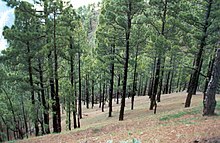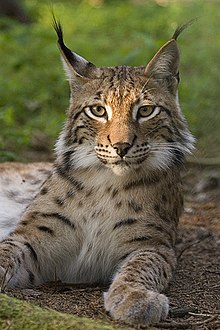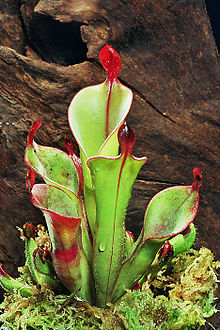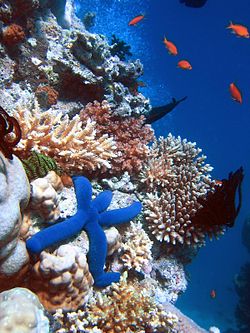Biodiversity


According to the International Convention on Biological Diversity, biodiversity or biological diversity is the term used to refer to the wide variety of living beings on Earth and what happens to the natural patterns that make it up, the result of billions of years of evolution according to natural processes and also the growing influence of human activities. Biodiversity also includes the variety of ecosystems and the genetic differences within each species (genetic diversity) that allow the combination of multiple forms of life, and whose mutual interactions with the rest of the environment support the support of life in the world.
The term "biodiversity" is a calque of the English "biodiversity". This term, in turn, is a contraction of the expression «biological diversity» that was used for the first time in October 1986 as the title of a conference on the subject, the National Forum on BioDiversity, convened by Walter G. Rosen, who is credited with the idea for the word.
The Earth Summit, held by the United Nations Organization in Rio de Janeiro in 1992, recognized the global need to reconcile the future preservation of biodiversity with human progress according to criteria of sustainability or sustainability promulgated in the International Convention on Biological Diversity that was approved in Nairobi on May 22, 1994, a date later declared by the UN General Assembly as International Day for Biodiversity. With this same intention, the year 2010 was declared the International Year of Biological Diversity by the 61st session of the United Nations General Assembly in 2006, coinciding with the date of the 2010 Biodiversity Target.
In 2007, the Assembly of the United Nations Organization declared May 22 as the International Day for Biological Diversity.In 2022, at COP15 in Montreal, around 200 countries adopted an agreement to protect at least 30% of the world's land and sea areas by 2030.
Origin and evolution of the term
According to the RAE, the term biodiversity defines the "Variety of animal and plant species in their environment"
However, the concept, due to its intuitive nature, has presented certain difficulties for its precise definition, as Fermín Martín Piera pointed out when arguing that abuse in its use could "empty it of content", since in his words: "It often happens in the history of thought that the new paradigms coexist for a time with the old ideas", considering along with other authors that the concept of biodiversity was already pointed out by the theory of evolution itself.
At the beginning of the XX century, the ecologists Jaccard and Gleason proposed in different publications the first statistical indices aimed at comparing the internal diversity of ecosystems. In the mid XX century, growing scientific interest allowed the development of the concept to describe complexity and organization, until in 1980, Thomas Lovejoy proposed the term biological diversity.
Definition
If in the field of biology, biodiversity refers to the number of populations of organisms and different species, for ecologists the concept includes the diversity of lasting interactions between species and their immediate environment or biotope, the ecosystem in which organisms live. In every ecosystem, living organisms are part of a whole, interacting with each other, but also with the air, water, and soil that surround them.
There are usually three levels of biodiversity:
- Genetics or intra-specific diversity, consisting of the diversity of gene versions (alleles) and their distribution, which in turn is the basis of inter-individual variations (the variety of genotypes).
- Specific, understood as systematic diversity, consisting of the plurality of genetic systems or genomes that distinguish species.
- Ecosystem, the diversity of biological communities (biocenosis) whose integrated sum is the biosphere.
Internal diversity of ecosystems must also be included, to which the expression ecological diversity traditionally refers.
Biodiversity and evolution
The biodiversity found on Earth today is the result of four billion years of evolution.
Although the origin of life has not been able to be dated with precision, the evidence suggests that it could have arisen between 3,800 and 3,235 million years ago. Some more recent research has opened up the possibility that it began even ago. 4100 million years, although they are not yet conclusive. Until about 600 million years ago, all life consisted of bacteria and microorganisms.
The history of biological diversity during the Phanerozoic—the last 540 million years—begins with rapid growth during the Cambrian explosion, the period during which phyla of multicellular organisms first appeared. For the next 400 million years years global biodiversity showed a relative advance, but it was marked by specific events of mass extinctions.
The apparent biodiversity shown in the fossil record suggests that the recent few million years include the most biodiverse period in Earth's history. However, not all scientists hold this point of view, since it is not easy to determine if the abundant fossil record is due to an explosion of biodiversity, or —simply— to the better availability and conservation of the most recent geological strata. [citation required]
Some, like Alroy et al., think that by improving sampling, modern biodiversity does not differ much from 300 million years ago. Estimates of current macroscopic species range from 2 to 100 million, with a logical estimate of approximately 10 million species.
Most biologists agree, however, that the period since the appearance of man is part of a new mass extinction, the Holocene extinction event, caused especially by the impact that humans have on the development of the ecosystem. It is estimated that the number of species extinct due to human activity is even less than those observed during the mass extinctions of previous geological eras.[citation needed] However, many believe that the current rate of extinction is sufficient to create a major mass extinction in less than 100 years.[citation needed] Those who disagree with this hypothesis argue that the current rate of extinction may be sustained for several thousand years before biodiversity loss exceeds the 20% observed in past mass extinctions.[citation needed]
New species are regularly discovered—an average of three birds per year—[citation needed] and many already discovered have not yet been classified: an estimated 40 % of South American freshwater fish remain unclassified.[citation needed]
Importance of biodiversity
The essential and fundamental value of biodiversity resides in the fact that it is the result of a natural historical process of great antiquity. For this reason alone, biological diversity has the inalienable right to continue its existence. Man and his culture, as a product and part of this diversity, must ensure that it is protected and respected.
In addition, biodiversity is a guarantor of well-being and balance in the biosphere. The various elements that make up biodiversity make up true functional units, which provide and ensure many of the basic "services" for our survival.
Finally, from our human condition, diversity also represents natural capital. The use and benefit of biodiversity has contributed in many ways to the development of human culture, and represents a potential source to meet future needs.
Considering biological diversity from the point of view of its present and potential uses and benefits, it is possible to group the arguments into three main categories.
The ecological aspect
Refers to the role of biological diversity from the systemic and functional point of view (ecosystems). Being indispensable to our very survival, many of these functions are often called “services”.
The elements that constitute the biological diversity of an area are the natural regulators of the flows of energy and matter. They play an important role in regulating and stabilizing land and coastal zones. For example, on mountain slopes, the diversity of species in the vegetal layer forms true tissues that protect the underlying inert layers from the mechanical action of elements such as wind and runoff water. Biodiversity plays a determining role in atmospheric and climatic processes. Many exchanges and effects of the continental masses and the oceans with the atmosphere are the product of living elements (albedo effect, evapotranspiration, carbon cycle, etc.).
The biotic diversity of a natural system is one of the determining factors in the processes of recovery and reconversion of waste and nutrients. In addition, some ecosystems have organisms or communities capable of degrading toxins, or naturally fixing and stabilizing dangerous compounds.
Even with the development of agriculture and the domestication of animals, biological diversity is essential to maintain a good functioning of agroecosystems, since it guarantees the fertility of the land, the natural pollination of several domestic species, the effective control of pests, etc. The trophodynamic regulation of biological populations is only possible by respecting the delicate networks that are established in nature. Imbalance in these relationships has already been shown to have significant negative consequences. This is even more evident with marine resources, where most of the world's consumed food sources are caught directly from the environment. The response to disturbances (natural or anthropogenic) takes place at a systemic level, through response pathways that tend to return to the initial equilibrium situation. However, human activities have increased dramatically in terms of intensity, irreparably affecting the biological diversity of some ecosystems and in many cases violating this response capacity with catastrophic results.
Research suggests that a more diverse ecosystem can better withstand environmental stress and is therefore more productive. The loss of a species is likely to decrease the ability of the system to sustain itself or recover from damage or disturbance. Like a species with high genetic diversity, an ecosystem with high biodiversity may have more opportunities to adapt to environmental change. In other words: the more species an ecosystem comprises, the more likely the ecosystem is to be stable and resilient. The mechanisms underlying these effects are complex and hotly contested. However, in recent years it has become clear that there are indeed ecological effects of biodiversity.
A high availability of resources in the environment favors a greater biomass, but also ecological dominance and often relatively nutrient-poor ecosystems present greater diversity, something that is systematically true in aquatic ecosystems. Greater biodiversity allows an ecosystem to better resist major environmental changes, making it less vulnerable, more resilient, since the state of the system depends on the interrelationships between species and the disappearance of any of them is less crucial for the stability of the whole than in ecosystems. less diverse and more marked by dominance.
The economic aspect
For all humans, biodiversity is the first resource for daily life. An important aspect is the diversity of the crop, which is also called agrobiodiversity.
Most people see biodiversity as a repository of useful resources for the manufacture of food, pharmaceuticals and cosmetics. This concept of biological resources explains most of the fears of disappearing resources. However, it is also the origin of new conflicts over the division and appropriation of natural resources.
Some of the important economic items that biodiversity provides to humanity are:
- Food: crops, livestock, forestry, fish farming, medicines. Wild plants have been used for medicinal purposes since prehistory. For example, quinine comes from the quina tree (treats malaria); the digital, from the Digital Plant (chronic arrhythmia problems); and the morphine, from the poppy (anesthesia). Animals can also play a role, particularly in research. It is estimated that of the 250 000 species of known plants, only 5000 have been investigated for possible medical applications. But maintaining biodiversity is not only important in case there are "new" species, which are not yet discovered, which can be economically exploited; it is also important to keep it as a "genemine", a reserve of interesting characteristics (resistance to droughts, pests, soil salinity) that can be incorporated, if deemed appropriate, into current agricultural species (trigo, barley, corn, vine) through genetic engineering.
- Industry: for example, textile fibres, wood for coverage and heat. Biodiversity can be a source of energy (such as biomass). Biodiversity also includes the largest reserve of biochemical compounds imaginable, due to the variety of metabolic adaptations of organisms. Other industrial products we currently obtain are oils, lubricants, perfumes, dyes, paper, waxes, rubber, latex, resins, poisons, cork.
- Health: In addition to being a very rich source of molecules, some of which have medicinal effects, greater biodiversity promotes a lesser extent and severity of infectious diseases, and therefore high costs associated with them.
- Animal supplies include wool, silk, skin, meat, leather, lubricants and waxes. Animals can also be used as transport.
- Tourism and recreation: biodiversity is a source of cheap wealth for many areas, such as parks and forests where wild nature and animals are a source of beauty and joy for many people. Ecotourism, in particular, is growing in outdoor recreational activity. Moreover, a large part of human cultural heritage in various fields (gastronomic, educational, spiritual) is closely linked to local or regional diversity and will surely continue to be.
Ecologists and environmental activists were the first to stress the economics of protecting biodiversity.
Estimating the value of biodiversity is a necessary precondition for any discussion on the distribution of its wealth. This value can be discriminated between use value (direct such as tourism or indirect such as pollination) and intrinsic value.
If biological resources represent an ecological interest for the community, their economic value is also increasing. New products are developed due to biotechnologies and new markets. For society, biodiversity is also a field of activity and profit. It requires an appropriate management arrangement to determine how these resources will be used.
The current and future economic importance of most species has yet to be assessed. However, we must be aware that we still have a long way to go to know how to calculate accurately, not only economically but, much more importantly, the value that each species has for its ecosystem.
The demographic and economic expansion of the human species is generally considered to be setting in motion a mass extinction, incomparably larger than any previous extinction. The concrete causes are in the indiscriminate disappearance of ecosystems, due to the felling of forests, soil degradation, environmental pollution, excessive hunting and fishing, etc. Such an extinction is generally judged by the scientific community to pose a threat to the biosphere's ability to support human life through various natural services and renewable resources.
That is why the understanding of cultural biodiversity in its relationship with ecosystems is key, as long as natural resources are not dissociated from their cultural, historical and geographical context.
The scientific aspect
Biodiversity is important as each species can give scientists a clue about the evolution of life. In addition, biodiversity helps science to understand how the vital process works and the role that each species has in ecosystems.
Assessing biodiversity
Parameters
Diversity is a phenomenological property that aims to express the variety of different elements. As a fundamental quality of our perception, we feel the need to quantify it. The development of a measure that makes it possible to express biological diversity in a clear and comparable manner presents difficulties and limitations. It is not simply a question of measuring a variation of one or several common elements, but of quantifying and weighing how many different elements or groups of elements exist. The existing diversity measures, then, are nothing more than quantitative or semi-quantitative models of a qualitative reality with very clear limits in terms of their applications and scope. The development of a logical and coherent mathematical concept for the modeling of biological diversity at the specific and genetic level has been well explored and presents a synthetic and robust body. Modeling of diversity at the ecosystem level is more recent, and has benefited from technological advances (such as GIS). The simplest measures of diversity consist of mathematical indices that express the amount of information and the degree of organization Of the same. Basically, the metric expressions of diversity take into account three aspects:
- Rice: It's the number of elements. According to the level, this is the number of alleles or heterozygosis (genetic level), the number of species (specific level), or the number of habitats or different environmental units (ecosystem level).
- Relative abundance: It is the relative incidence of each element in relation to others.
- Difference: It is the degree of genetic, taxonomic or functional differentiation of the elements.
Each of these diversity indices is one-dimensional and of limited reading. Comparisons and valuations of biological diversity are necessarily incomplete in these terms. They are used due to their practical and synthetic nature, but insufficient compared to alternative multi-scale and multi-dimensional analytical models that better respond to specific conservation and management needs. Thus, two-dimensional modeling (richness and relative abundance) can be considered the "classic" standard for measuring and expressing diversity. According to the spatial scale in which biological diversity is measured, we speak of alpha diversity (point diversity, represented by α), beta (diversity between habitats, represented by by β) and gamma (regional scale diversity, represented by γ). These terms were coined by Robert Whittaker in 1960 and are generally widely accepted.
Dynamics
Biodiversity is not static: it is a system in constant evolution, both in each species, as well as in each individual organism. A living species may have started one to four million years ago, and 99% of the species that have ever existed on Earth have gone extinct.
Biodiversity is not evenly distributed on earth. It is richest in the tropics, and as one approaches the polar regions one finds larger populations and fewer species. The flora and fauna vary, depending on the climate, altitude, soil and the presence of other species.
Spatial units and biodiversity
The distribution of current biological diversity is the result of evolutionary, biogeographical and ecological processes over time since the appearance of life on earth. Its existence, conservation and evolution depend on the environmental factors that make it possible. Each species presents specific environmental requirements without which it is not possible to survive. Although orographic and oceanographic, altitudinal and latitudinal changes make it possible to define landscape units with a fair approximation, the specific component of the species present is what finally allows the identification of relatively homogeneous areas in terms of the characteristics it presents or offers for biological populations.
These biosphere units can be identified as biodiversity units according to different assessment criteria: for example, the number of endemism, specific, ecosystemic or phylogenetic richness. Although it is common to argue that this or that country presents certain biodiversity indices, the spatial units of biological diversity are by definition independent of geopolitical limits or barriers.
Two of the current spatial units of the biosphere, where the factor of biodiversity precedes in importance, are the Global 200 ecoregions identified by the WWF and the biodiversity hotspots or hotspots of the International Union for Conservation of Nature.
Global 200 identifies the most important ecoregions on the planet, both marine and continental —bodies of fresh water and terrestrial— according to specific richness, number of endemic species, and conservation status.
The term "biodiversity hotspot" was coined by Norman Myers in 1998 and identifies important terrestrial biogeographic regions based on the number of endemism and the degree of threat to biodiversity. In its latest review, Conservation International proposes 34 hotspots.
Threats
During the XX century, the increasingly accelerated erosion of biodiversity has been observed. Estimates of extinction rates vary, from very few to as many as 201 extinct species per day, but all scientists acknowledge that the rate of species loss is greater than at any time in human history.
In the plant kingdom, it is estimated that approximately 12.5% of currently known species are threatened. All agree that the losses are due to human activity, including the direct destruction of plants and their habitat.
There is also a growing concern about the human introduction of exotic species in certain habitats, altering the trophic chain.
Human activities aimed at development that can affect biodiversity
Some examples of development activities that may have the most significant negative consequences for biodiversity are:
- Agricultural projects and ranchers that involve landslide, the elimination of wet land, flooding for irrigation reservoirs, the displacement of wildlife through pigs or domestic livestock, the intensive use of pesticides, the introduction of the monoculture of commercial products in places that previously depended on a large range of local crops for subsistence farming.
- Pyscculture projects that include the conversion, for aquaculture or mariculture, of important natural breeding sites, overfishing, the introduction of exotic species in natural aquatic ecosystems.
- Forest projects that include construction of access roads, intensive forest exploitation, establishment of forest products industries that generate more development near the project site.
- Transport projects covering the construction of main roads, bridges, rural roads, railways or canals, which could facilitate access to and the population of natural areas.
- Channeling the rivers.
- Dredging and filling activities in wet coastal or indoor lands.
- Hydroelectric projects that involve large deviations of water, floods or other major transformations of aquatic or terrestrial natural areas, producing the reduction or modification of the habitat and the consequent relocation necessary to new areas and the probable violation of maintenance capacity.
- Irrigation and other drinking water projects that can drain water, drain habitats on wet lands or remove vital water sources.
- Industrial projects that produce air, water or soil pollution.
- Large-scale habitat loss, due to mining and mineral exploration.
- Conversion of biological resources for industrial fuels or food.
- Human overpopulation and anthropocentrism.
- Pets like dogs and cats.
Sociocultural aspects
To the foregoing, we can meaningfully add cultural biodiversity. Work on biological biodiversity is incorporating the study, promotion and protection of cultural biodiversity, as well as specific biodiversity, ecosystems and genetics.
Eugenio Reyes Naranjo defines Cultural Biodiversity as diversity of knowledge that human beings have developed throughout history in their relationship with biodiversity.
This includes beliefs, myths, dreams, legends, language, scientific knowledge, psychological attitudes in the broadest possible sense, management, use, enjoyment and understanding of the natural environment.
It is about understanding biological evolution taking into account all aspects of human intervention.
Contenido relacionado
Dihoplus kirchbergensis
Aepyceros melampus
Chasmanthium





